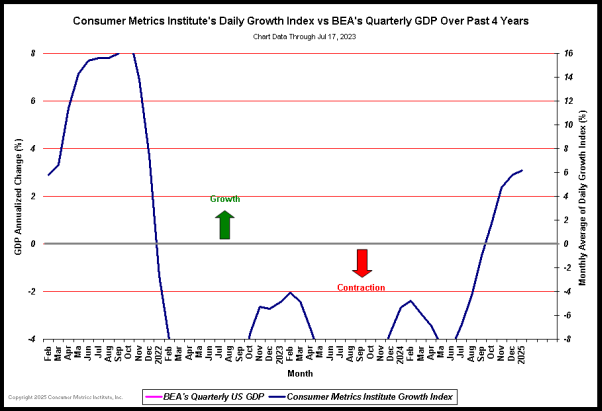Doug Short compared recent data from Rick at Consumer Metrics Institute using chart overlays of the GDP and S&P. He also provides additional commentary. (In case you missed my interview with Rick back in April, it’s here.) – Ilene
Consumer Metrics Institute Growth Index
Courtesy of Doug Short
Note from dshort: The 91-day Growth Index continues its downward slide with data now available though July 29th. Note that the Real GDP numbers are updated with the BEA’s revised estimates from 2007 through First Quarter 2010. See the explanation here.
The three charts below focus on the ‘Trailing Quarter’ Growth Index, which is computed as a 91-day moving average for the year-over-year growth/contraction of the Weighted Composite Index. The index gives a nearly real-time daily snapshot of consumer behavior across a wide variety of consumption categories. The 91-day period is useful for comparison with key quarterly metrics such as GDP. Since the consumer accounts for over two-thirds of the US economy, one would expect that a well-crafted index of consumer behavior would serve as a leading indicator. As the chart suggests, during the five-year history of the index, it has generally lived up to that expectation. Actually, the chart understates the degree to which the Growth Index leads GDP. Why? Because the advance estimates for GDP are released a month after the end of the quarter in question, so the Growth Index lead time has been substantial.
Has the Growth Index also served as a leading indicator of the stock market? The next chart is an overlay of the index and the S&P 500. The Growth Index clearly peaked before the market in 2007 and bottomed in late August of 2008, over six months before the market low in March 2009.
The most recent peak in the Growth Index was around the first of September, 2009, almost eight months before the interim high in the S&P 500 on April 23rd. Since its peak, the Growth Index has declined dramatically and is now well into contraction territory.
It’s important to remember that the Growth Index is a moving average of year-over-year expansion/contraction whereas the market is a continuous record of value. Even so, the pattern is remarkable. The question is whether the latest dip in the Growth Index is signaling a substantial market decline like in 2008-2009 or a buying opportunity like in June 2006.
The next chart is a three-way overlay — the 91-day Growth Index, GDP and the S&P 500. I’ve also highlighted the recession that officially began in December 2007 and unofficially ended last summer. As a leading indicator for GDP, the Growth Index also offers an early warning for possible recessions.
Preliminary Conclusion
The Consumer Metrics Institute’s Growth Index hasn’t been in operation very long, but thus far it has been an effective leading indicator of GDP. As such, the prospect of a double-dip recession, something that’s happened only once since the Great Depression, remains a possibility.






